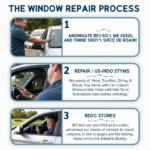Discovering water damage on your leather car seats can be a frustrating experience. Whether it’s from a spilled drink, rain seeping in through an open window, or even flood damage, water can wreak havoc on leather upholstery. Left untreated, water damage can lead to unpleasant odors, mold growth, and permanent staining. But don’t panic just yet! Understanding how to repair water-damaged leather car seats can save you from costly replacements and restore your car’s interior to its former glory.
Assessing the Damage: How Bad Is It?
Before diving into the repair process, it’s essential to assess the extent of the water damage. This will help you determine the appropriate cleaning and restoration methods.
- Minor Damage: This includes light water stains, slight discoloration, and a musty odor. Minor damage can often be addressed with simple cleaning solutions and DIY techniques.
- Moderate Damage: This involves more pronounced water stains, deeper discoloration, and a stronger, unpleasant odor. Moderate damage may require specialized leather cleaning products and techniques.
- Severe Damage: This encompasses significant water damage, widespread staining, mold growth, and a persistent foul odor. Severe damage often necessitates professional intervention for effective restoration.
DIY Solutions for Minor Water Damage
If you’re dealing with minor water damage on your leather car seats, you can often remedy the situation with readily available household items and some elbow grease. Here’s a step-by-step guide:
- Air Dry: Open the car doors and windows to allow for maximum ventilation and air circulation. This helps to naturally dry out the affected area and prevent further moisture absorption.
- Vacuum: Thoroughly vacuum the seats to remove any loose dirt, debris, and crumbs that could hinder the cleaning process.
- Mild Soap Solution: Create a gentle cleaning solution by mixing a few drops of mild dish soap with warm water. Avoid using harsh chemicals, as they can strip the leather of its natural oils and cause further damage.
- Gentle Cleaning: Dampen a soft microfiber cloth with the soap solution and gently wipe down the affected area in a circular motion. Avoid soaking the leather.
- Rinse and Dry: Use a clean, damp cloth to remove any soap residue. Then, use a dry microfiber cloth to thoroughly dry the seats.
- Conditioning: Once the seats are completely dry, apply a high-quality leather conditioner to restore moisture and protect the leather.
When to Call a Professional
While DIY methods can be effective for minor water damage, moderate to severe damage often requires professional expertise and specialized equipment. Here are signs it’s time to seek professional help:
- Persistent Odors: If a musty or foul odor lingers even after cleaning, it could indicate mold or mildew growth that requires professional treatment.
- Deep Staining: Stubborn water stains that resist DIY cleaning methods may need professional-grade cleaning products and techniques.
- Mold Growth: Visible mold growth on your leather seats requires immediate professional attention to prevent health risks and further damage.
- Severe Damage: Extensive water damage, particularly from flooding, necessitates professional restoration to address potential structural issues and ensure thorough cleaning and drying.
Preventing Future Water Damage
Prevention is key to protecting your leather car seats from future water damage. Here are some proactive measures:
- Waterproof Seat Covers: Invest in high-quality waterproof seat covers to provide an extra layer of protection against spills and moisture.
- Regular Cleaning: Establish a routine cleaning schedule for your leather seats, using appropriate cleaning products and techniques to remove dirt, spills, and moisture before they can cause damage.
- Prompt Spill Cleanup: Address spills immediately to prevent liquids from penetrating the leather and causing stains.
- Park Smartly: Whenever possible, park your car in shaded areas or utilize a car cover to protect the interior from prolonged sun exposure and potential water damage.
Remember, taking swift action and employing the right techniques can make all the difference in repairing water-damaged leather car seats and restoring your vehicle’s interior to its pristine condition.


